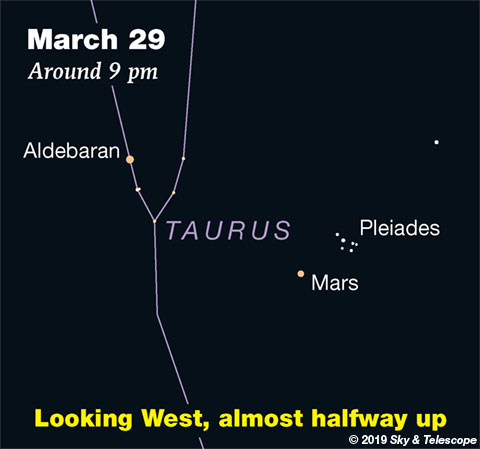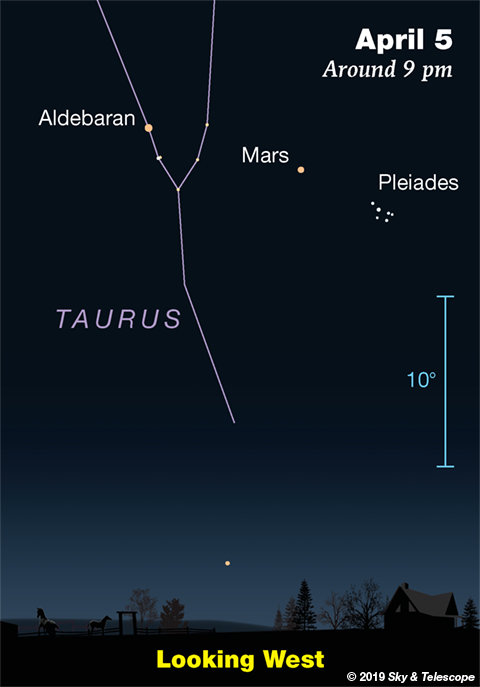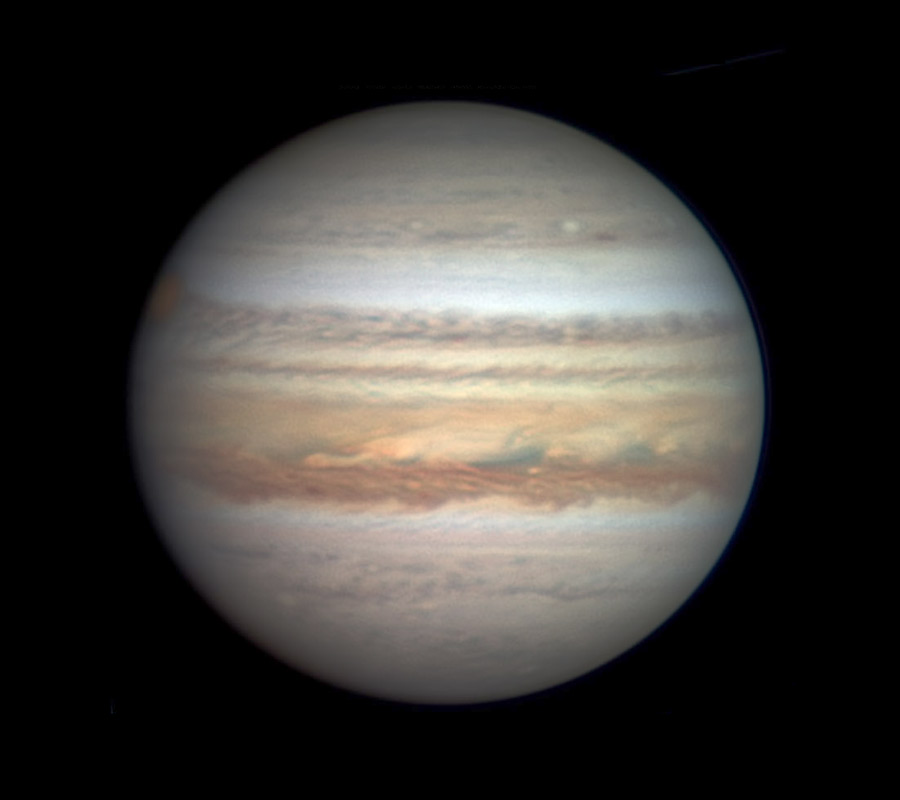

Friday, March 29
• In the western sky after dusk, orange Mars is passing just 3° from the delicate, blue-white Pleiades cluster this evening through Sunday evening.
Saturday, March 30
• Castor and Pollux shine together very high in the south after dark, very far upper left of Mars and Aldebaran. Pollux is slightly the brighter of these Gemini "twins."
Draw a line from Castor through Pollux, follow it farther lower left by a big 26° (about 2½ fist-widths at arm's length), and you're at the dim head of Hydra, the Sea Serpent. In a dark sky it's a subtle but distinctive star grouping, about the size of your thumb at arm's length. Binoculars show it easily through light pollution.
Continue the line farther by a fist and a half and you hit Alphard, Hydra's 2nd-magnitude orange heart.
Another way to find the head of Hydra: It's almost midway from Procyon to Regulus.
Sunday, March 31
• High above the Big Dipper late these evenings, nearly crossing the zenith, are three pairs of dim naked-eye stars, all 3rd or 4th magnitude, marking the Great Bear's feet. They're also known as the Three Leaps of the Gazelle, from early Arab lore. They form a long line roughly midway between the bowl of the Big Dipper and the Sickle of Leo; see the evening constellation chart in the center of the April Sky & Telescope.
According to Arab lore, the gazelle was drinking at a pond — the big, dim Coma Berenices star cluster — and bounded away when startled by a flick of Leo's nearby tail, Denebola. Leo, however, seems quite unaware, facing the other way.
• A dawn challenge: About 30 minutes before sunrise Monday morning, scan just above the east-southeast horizon for the thin crescent Moon to the right of Venus. Bring binoculars if you have them.
Monday, April 1
• The huge, bright Winter Hexagon is still in view just after dark, filling the sky to the southwest and west. Start with brilliant Sirius in the southwest, the Hexagon's lower left corner. High above Sirius is Procyon. From there look even higher for Pollux and Castor, rightward from Castor to Menkalinan and bright Capella, lower left from there to Aldebaran, lower left to Rigel at the bottom of Orion, and back to Sirius.
Tuesday, April 2
• Bright Capella shines high in the northwest after dusk. Its pale-yellow color matches that of the Sun, meaning they're both about the same temperature. But otherwise Capella is very different. It consists of two yellow giant stars, larger and brighter than the Sun, orbiting each other every 104 days.
Moreover, for telescope users, it's accompanied by a distant, tight pair of red dwarfs: Capella H and L, magnitudes 10 and 13. Article and finder charts.
Wednesday, April 3
• In this dark-of-the-Moon time, explore springtime galaxies for your small scope using a sky atlas and the Deep-Sky Wonders article in the April Sky & Telescope, page 54. And for much tougher dark-sky challenges, try for big, dim galactic cirrus clouds using the Going Deep article and charts on page 57.
Thursday, April 4
• This evening, you'll find that Mars is right on the line between Aldebaran and the Pleiades.
Friday, April 5
• Shortly after the end of twilight at this time of year, Arcturus, the bright Spring Star climbing in the east, stands just as high as Sirius, the brighter Winter Star descending in the southwest (for viewers at mid-northern latitudes).
These are the two brightest stars in the sky at the time. But Capella is a very close runner-up to Arcturus! Spot it high in the northwest.
• New Moon (exact at 3:50 a.m. on this date EDT).
Saturday, April 6
• The asteroid 2 Pallas is at opposition and detectable in good binoculars at magnitude 7.9, the same brightness as Neptune. It's only 4° from Arcturus tonight, on its way to passing very close by Eta Bootis on the evening of April 10th.
And, smaller 7 Iris is also about at opposition. It's farther south in Corvus and only magnitude 9.4. See Bob King's Pop In on Pallas and Iris Tonight, with finder charts.
________________________
Want to become a better astronomer? Learn your way around the constellations. They're the key to locating everything fainter and deeper to hunt with binoculars or a telescope.
This is an outdoor nature hobby. For an easy-to-use constellation guide covering the whole evening sky, use the big monthly map in the center of each issue of Sky & Telescope, the essential guide to astronomy.

Once you get a telescope, to put it to good use you'll need a detailed, large-scale sky atlas (set of charts). The basic standard is the Pocket Sky Atlas (in either the original or Jumbo Edition), which shows stars to magnitude 7.6.
Next up is the larger and deeper Sky Atlas 2000.0, plotting stars to magnitude 8.5; nearly three times as many. The next up, once you know your way around, are the even larger Interstellarum atlas (stars to magnitude 9.5) and Uranometria 2000.0 (stars to magnitude 9.75). And read how to use sky charts with a telescope.
You'll also want a good deep-sky guidebook, such as Sue French's Deep-Sky Wonders collection (which includes its own charts), Sky Atlas 2000.0 Companion by Strong and Sinnott, or the bigger Night Sky Observer's Guide by Kepple and Sanner.
Can a computerized telescope replace charts? Not for beginners, I don't think, and not on mounts and tripods that are less than top-quality mechanically (meaning heavy and expensive). And as Terence Dickinson and Alan Dyer say in their Backyard Astronomer's Guide, "A full appreciation of the universe cannot come without developing the skills to find things in the sky and understanding how the sky works. This knowledge comes only by spending time under the stars with star maps in hand."
Mercury is very deep in the glare of sunrise, down to the lower left of Venus.
Venus (magnitude –3.9) rises above the east-southeast horizon in early dawn. It's still quite low by the time dawn grows bright.
Mars (magnitude +1.5, in Taurus) glows in the west after dusk. It's the orange-red spark near the Pleiades, lower left of brighter orange Aldebaran. Mars this season is about as far from us as it ever gets; in a telescope it's a tiny blob 4.6 arcseconds across.

Jupiter (magnitude –2.3, in the feet of Ophiuchus) rises in the southeast around 1 a.m. daylight-saving time. It's high in the south just as dawn begins to brighten, the best time to observe it telescopically. The farther south you are, the higher it will be.
Saturn (magnitude +0.6, in Sagittarius) glows in early dawn, to the left or lower left of Jupiter by about 26°.
Uranus and Neptune are out of sight behind the glare of the Sun.
______________________
All descriptions that relate to your horizon — including the words up, down, right, and left — are written for the world's mid-northern latitudes. Descriptions that also depend on longitude (mainly Moon positions) are for North America.
Eastern Daylight Time (EDT) is Universal Time (UT or GMT) minus 4 hours.
______________________
Audio sky tour. Out under the evening sky with your earbuds in place, listen to Kelly Beatty's monthly podcast tour of the heavens above. It's free.
______________________
"I do not know what I may appear to the world; but to myself I seem to have been only like a boy playing on the seashore, and diverting myself in now and then finding a smoother pebble or a prettier shell than ordinary, whilst the great ocean of truth lay all undiscovered before me."
— Isaac Newton, 1642–1727
(From the Memoirs of the Life, Writings, and Discoveries of Sir Isaac Newton, David Brewster, 1855)
______________________
 4
4








Comments
Rod
March 29, 2019 at 3:26 pm
any stargazing reports from Houston?
You must be logged in to post a comment.
mary beth
March 29, 2019 at 4:15 pm
Hi Rod! We’ve had partly cloudy skies and I got a very good view of beautiful Capella! I really enjoy following that star. Is it considered circumpolar? I know it’s visible for a long time. Of course all the usual suspects were visible, and Arcturus had such a lovely orange glow when it was coming up in the East. I’m also awaiting Spica to come over the tree line at a reasonable hour. Gotta love that grain of wheat! I like the way it is visible from the planting time to the harvest time. All that folklore is so fun and interesting to me.i love thinking about the ancient people, most of them probably could not even read, and the wonderful stories they came up with about the stars! This year is going fast and pretty soon Scorpius will be visible to enjoy all summer. How is your view of that constellation? Are you too far north to see?
You must be logged in to post a comment.
Rod
March 29, 2019 at 6:31 pm
mary beth, sounds like you have been enjoying some outdoor time viewing the stars too. Clouds here in my area now and rain likely tomorrow night. Capella in Auriga is not circumpolar, Ursa Major constellation is. I have no problem seeing Scorpius. This week during Last Quarter Moon, Scorpius is up before sunrise with Antares, Jupiter in Ophiuchus, and Saturn in Sagittarius. I have enjoyed some very good views using my 90-mm refractor telescope. Speaking of circumpolar stars, If you turn the telescope on Polaris, it is a double star (triple but double easy split). Polaris stays steady in the eyepiece when you time it but if I view other targets like Capella, Rigel double in Orion, or Sirius, at medium to higher power views, these targets can zip across the eyepiece 🙂 The Earth has a definite axis of rotation and easy to check and test 🙂 I have also enjoyed viewing 7 galaxies in Leo using my 10-inch telescope and also the globular cluster M3 in Canes Venatici. A really good globular view at 86x with many stars all around and bright core. I plan to do more galaxy and globular cluster stargazing this spring. On the 27th, I was out enjoying the telescope view of 5 open clusters located in Canis Major, Puppis, and Hydra constellations. 20th-24th of March, sunspot AR2736 erupted, it was more than 100,000 km size, much larger than Earth. I enjoyed that large sunspot area too and solar rotation visible as it disappeared to the other side of the Sun. I have enjoyed some really good viewing lately, outdoor time at night as well as solar observing using my white light solar filter.
You must be logged in to post a comment.
Rod
April 1, 2019 at 7:22 am
Great early morning sky views here today. I was out 0500-0600 EDT, waning crescent Moon rise near 0521 EDT. I enjoyed telescope views of M4 globular cluster in Scorpius, Jupiter and the 4 Galilean moons in Ophiuchus, and Saturn with Titan easy to see in Sagittarius with a number of stars all around in the field of view. Clear skies with temp 29F. I used my trusty 90-mm refractor with 14-mm eyepiece for 71x and 1-degree true FoV. Some of the outer giant stars in M4 resolved too. Jupiter is getting brighter now as it approaches opposition on 09-June this year. It was windy though, NW winds 15 knots gusting 24 knots at times.
You must be logged in to post a comment.
You must be logged in to post a comment.